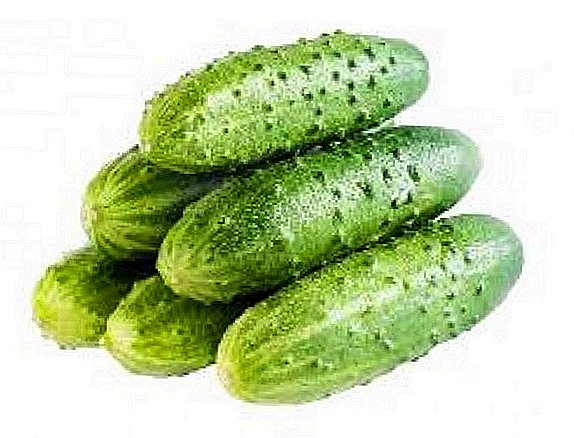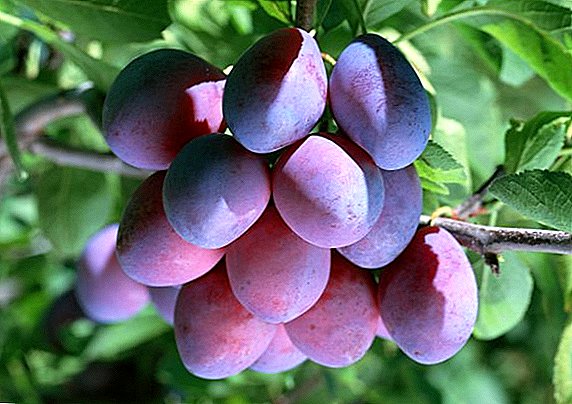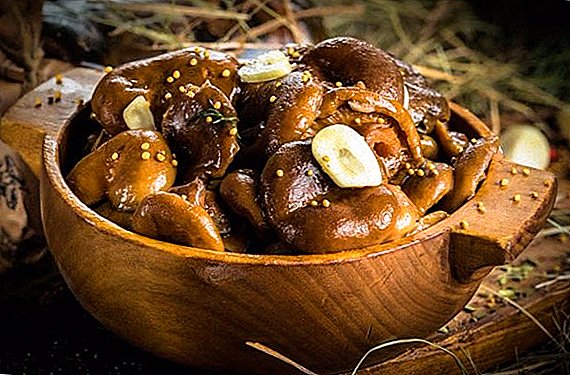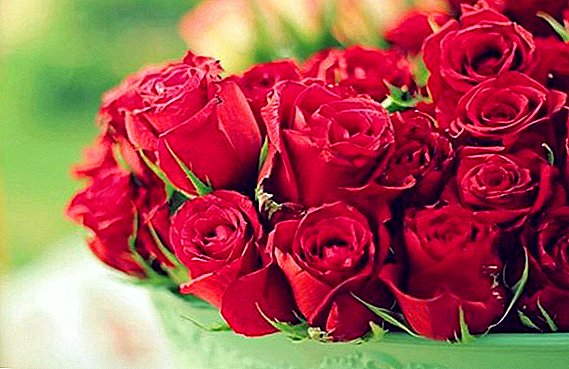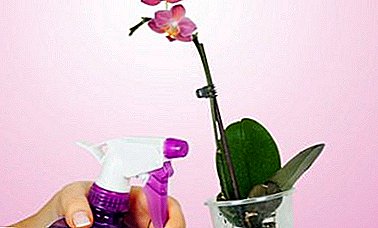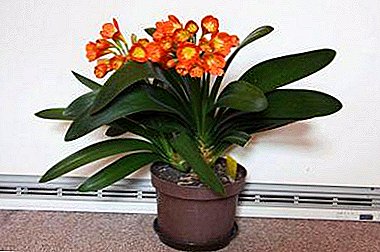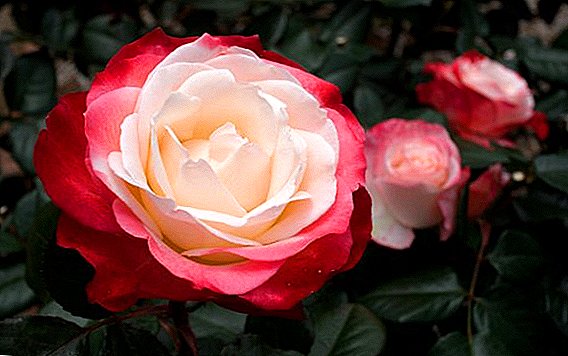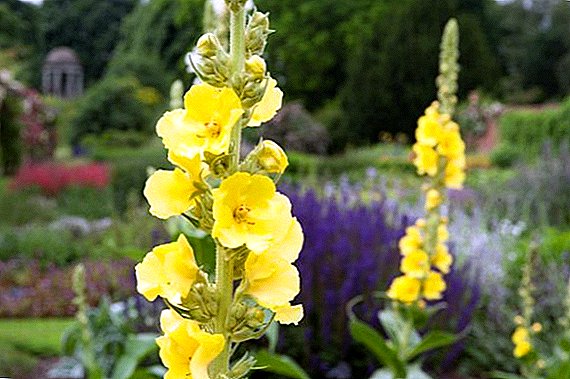 Today, many plants are used in traditional medicine to combat various diseases. In our article we will tell you what a mullein is, what types of plants are and how to grow and use it properly to treat diseases.
Today, many plants are used in traditional medicine to combat various diseases. In our article we will tell you what a mullein is, what types of plants are and how to grow and use it properly to treat diseases.
Botanical description
Korovyak is a biennial herb with an erect stem, its height reaches 150 cm. It has large leaves that have an ovoid shape - those that are located at the bottom have the largest size.
Most often, the plant has small flowers that are painted in a light yellow color and are collected in a thick brush. There is also a purple variety of mullein, whose flowers are collected in a brush with a pyramidal shape.
Important! Fertile soils are not suitable for planting mullein - the plant will practically not bloom on them and will soon die.
Panicle mullein is characterized by white color of flowers with yellowness. It differs in that it is covered with thick down. Plant blooms all summer. The fruits are represented by round brown boxes, have a specific smell.  Best of all, mullein grows in sandy soil and subject to good lighting. The most common places of its growth are meadows of hills and forest edges.
Best of all, mullein grows in sandy soil and subject to good lighting. The most common places of its growth are meadows of hills and forest edges.
Chemical composition
Korovyak is rich in various useful elements. It contains a large number:
- ash;
- saponins;
- tanning elements;
- essential oils;
- gums;
- alpha crocetin;
- irinoids;
- glycosides;
- flavonoids;
- alkaloids;
- ascorbic acid;
- beta carotene.

In addition, in the mullein large content:
- potassium;
- calcium;
- magnesium;
- gland;
- magnesium;
- zinc;
- sulfur.
Popular species: what looks like mullein
Today there are several varieties of mullein. Consider the most common ones.
Ordinary (bear ear)
The most common is the bear's ear. Its peculiarity lies in the dense pubescence of all parts of the plant with a light gray nap. The leaves are painted dark green and evenly distributed throughout the shoot. At the top of the plant you can observe a short inflorescence, similar to the spikelet.  The length of the lower leaves is 15-30 cm. Larger leaves are located in the root zone, and upwards their size decreases. This arrangement of foliage gives the plant a conical shape. The inflorescence includes a large number of small flowers, the diameter of which is up to 2 cm.
The length of the lower leaves is 15-30 cm. Larger leaves are located in the root zone, and upwards their size decreases. This arrangement of foliage gives the plant a conical shape. The inflorescence includes a large number of small flowers, the diameter of which is up to 2 cm.
Familiarize yourself with the beneficial properties of such herbaceous plants as bait, three leaf watch, awnless fire, wood louse, immortelle, Crimean iron, hemlock, goldenrod, sedge, white clover, colza, sverbig eastern, meadowsweet and dried weed.
Tall (royal scepter, densely flowered, scepter)
This species got its name due to a rather high altitude: in the royal - 1.5 meters, and in the densely flowered it can reach 2 meters. The plant has large pyatilepestkovye flowers with bright yellow color and irregular shape.  Their diameter is about 50 mm. Such a mullein differs in a dense arrangement of flowers and buds on a shoot - the gaps between them are very small. There is a plant on sandy soils, roadsides, in forests, parks.
Their diameter is about 50 mm. Such a mullein differs in a dense arrangement of flowers and buds on a shoot - the gaps between them are very small. There is a plant on sandy soils, roadsides, in forests, parks.
Cockroach
The height of this type is about 1 meter. It has a taproot, and has weakly branching stems. In the lower part of the stem is dense foliage, in the upper part the leaves have an oblong-ovate form. Inflorescences are quite large, have a pale yellow color.
The plant has 5 stamens and one pistil. The fruit is represented by a spherical box. Flowering occurs in June and July. Harvesting flowers and foliage occurs during the flowering period of the plant. 
Drug
The height of the stems of this species reaches 1.5 meters, they are distinguished by a thick cover of leaves. The upper part has an elongated inflorescence, which in some cases can branch into several shoots. On the surface of the whole plant there is a felt pile. The foliage is oval, blunt edge.
The length of the leaf is on average 15-25 cm. There are flowers on the plant, which have soft long petals that gather into inflorescences. The diameter of the inflorescences is different: from 3.5 cm to 5.5 cm. The anthers of the plant are red and clearly stand out. 
Did you know? Before textile dye was invented, mullein was used to dye fabrics: the sap of flowers could give them a rich yellow or green color.
The black
This species of mullein has a height of from 50 to 120 cm, has upright stems. Large leaves are located mainly in the lower part of the shoot. The stalked foliage is in the shape of an egg or a heart. Their length is about 20 cm. On a long inflorescence there are bunches of small yellow flowers.
The center of the petals is covered with brown specks, and on the stamens there are lilac fibers. A feature of this species is that only flowers are used for therapeutic purposes. 
Mealy
The plant has an erect stem, its height is about 130 cm. The leaves have a dentate, elongated shape. Flowers usually gather in a brush, after which they form a pyramidal panicle. The corolla is colored yellowish and has 5 blades. The fruit is represented by a box, it has 5 stamens.
Flowering captures all summer months. This species of mullein is most often found on hills or dry meadows. In folk medicine, rhizomes, foliage and flowers of the plant are used. 
Great
The height of the stem in a plant of this species can be from 1 to 2 meters. It has a strong structure, it is distinguished by its erectness, it branches a little to the top. Magnificent Mullein has whole foliage. The leaves placed at the bottom have an oblong-lanceolate form, their length is 20-40 cm, width - 3-6 cm.
The foliage located in the upper part has a heart-shaped form. Inflorescences are represented by a pyramidal panicle. The corolla is colored yellow, and the stamens are white. Boll has an oblong-obovate shape. 
The healing properties of mullein
Korovyak often used to combat various ailments, as it has the following therapeutic properties:
- diaphoretic;
The grass canoper, birch buds, anemone, gravilat, fragrant poultice, sow thistle, bedtime northern, ash, barberry and anise also have diaphoretic effects.
- diuretic;
- cardiotonic;
- astringent;
- anticonvulsant;
- hypotensive;
- antibacterial;
- enveloping;
- stops bleeding;
- eliminates pain;
- heals wounds;
- eliminates inflammation;
- soothes;
- promotes expectoration.
Video: healing properties of mullein
In the composition of the mullein there is mucus, which well eliminates inflammatory processes, perfectly envelops, promotes expectoration, with the result that sputum is better separated. Glucose is the main supplier of energy for the human body, it is necessary to stabilize metabolic processes, as well as ensure the normal activity of all systems and organs.
Thanks to the saponins that make up the plant, the sputum is diluted and excreted, the development of cancer cells is inhibited. In addition, they have anti-sclerotic, sedative, diuretic and expectorant effects.
Thanks to flavonoids, the vessels become more elastic, the capillaries are strengthened, the action of radicals is neutralized, the work of the central nervous system is normalized.
Due to the essential oils, the work of the heart and the gastrointestinal tract improves: they help to reduce cough and increase the separation of mucus, have a bactericidal, anti-inflammatory and sedative effect.  Gum, which is part of the plant, contributes to the stabilization of the digestive tract, the normalization of microflora, removes toxins, reduces cholesterol levels. Due to the effect of coumarins, blood thinning occurs - they have a diuretic, antiseptic, astringent effect.
Gum, which is part of the plant, contributes to the stabilization of the digestive tract, the normalization of microflora, removes toxins, reduces cholesterol levels. Due to the effect of coumarins, blood thinning occurs - they have a diuretic, antiseptic, astringent effect.
Carotene is a natural immunostimulant, helps to increase the body's resistance to various infections and viruses.
Iridoids that are part of the mullein have the following effect:
- antimutagenic;
- immunomodulatory;
Maple, black walnut, hawthorn, stevia magenta and turmeric also have immunomodulatory properties.
- resists viruses;
- hypoglycemic;
- choleretic;
- oxidative;
- eliminates inflammatory processes;
- antitumor;
- relieve pain;
- relieve cramps;

Thanks to the organic acids that are part of the mullein, you can remove inflammation in a short time: they have an antiseptic effect, improve sputum separation.
Tannins are distinguished by the presence of anti-inflammatory, antibacterial and astringent properties. Thanks to alkaloids, blood pressure is reduced and normalized, they are well anesthetized, have hemostatic and sedative effects.
Medical applications
In traditional medicine, broths and infusions from this plant are actively used. The use of such drugs helps to quickly get rid of cough, stomach ulcers and duodenal ulcers.
Important! During the preparation of infusions or decoctions, be sure to carefully remove the stamens, as they can cause irritation of the skin and mucous membranes.
This is possible because there are saponins and mucus in the mullein. Also, decoctions are used to treat skin diseases such as eczema, vitiligo, psoriasis. 
In addition, the use of tincture has a positive effect in the presence of:
- gingvitov;
- colitis;
- atherosclerosis;
For the prevention and treatment of atherosclerosis, medicinal vervain, chokeberry, horseradish, astragalus, iglitsa, onion peel and flax oil are also used.
- sore throats;
- stomatitis;
- neuralgia;
- cystitis;
- dystrophy;
- hypertension.
- Sometimes mullein is used as an independent ingredient, and sometimes in combination with other plants. In the complex of herbs can have the best effect.
- In the presence of kidney disease is recommended to regularly use a decoction of foliage foliage.
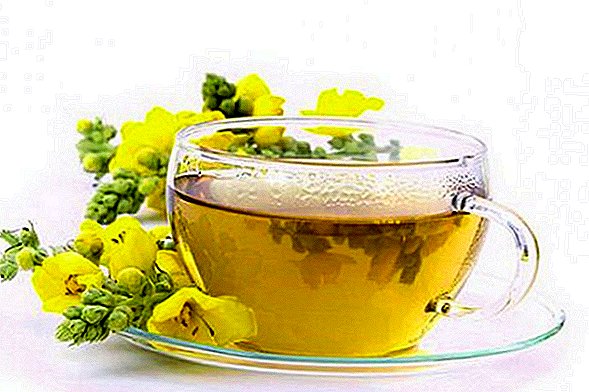
- Broth will also help to quickly cope with inflammatory processes in the bladder and various edemas.
- If you have respiratory problems, asthma or a cold, you should take an infusion of shoots, foliage and flowers.
- If diagnoses such as tuberculosis, inflammation of the lungs or pharynx are made, the infusion should be taken.
- In the presence of nervous disorders, it is recommended to use an infusion from the flowers of the plant.
- If your feet and joints hurt, you must rub them with alcohol oil tincture.
- For the treatment and healing of wounds will be effective lotions.
- Infusion will help to cope with epilepsy, headache, cramps.
Harm and contraindications
In general, the mullein does not have a large list of contraindications, but before using it you should definitely consult with your doctor.  You should also pay attention to the following points:
You should also pay attention to the following points:
- Not recommended to use infusions and decoctions of mullein during pregnancy and during lactation;
- it is forbidden to use mullein with individual intolerance;
- Be sure to filter infusions and decoctions, as small hairs, once in the esophagus and stomach, can cause irritation;
- it is forbidden to use the seeds of the plant inside - they are toxic;
- In some cases, due to the presence of tannin in the composition, mullein-based preparations are prohibited for people with cancer.
How to brew and prepare healing potions
We offer you the recipes of medicinal mixtures of mullein, which will help to cope with many diseases.
Decoction
In order to cook the broth, you must:
- 1 tbsp. spoon of dried mullein foliage;
- 200 ml of water.

The leaves must be ground, add water and boil for 1 minute. After that, the broth insist half an hour. Then it is worth filtering with the help of gauze, folded in several layers - this will help eliminate unnecessary villi.
Broth will help to cope with the disease such as cystitis, as well as it can be used as lotions to eliminate sores. Take 1 tbsp. spoon thrice a day.
For the treatment of cystitis in folk medicine, I also use cranberries, lingonberry leaves and a pine womb.
Ointment
To prepare the ointment you will need:
- mullein seeds;
- butter.
To prepare the ointment, you need to mix the seeds with oil in the ratio of 1 to 2 and thoroughly grind. This ointment will quickly get rid of purulent wounds and sores. Apply it should be 2 times a day on the affected areas. 
Tincture
To make a tincture that will help with radiculitis, arthritis and rheumatism, you will need:
- 1 tablespoon of plant flowers;
- 100 ml of alcohol.
It is necessary to mix these ingredients, put the tincture in a dark place for 14 days, then strain. Use in case of pain using the rubbing method.
To prepare the tincture for hair loss and seborrhea, you will need:
- 1 tablespoon of mullein;
- 500 ml of boiling water.
Did you know? Due to the fact that there are many villi on the surface of the plant, in the western United States it is popularly called "cowboy toilet paper".

It is necessary to fill the grass with water, insist in a thermos for 1.5-2 hours. Use tincture 150 ml three times a day. In addition to internal use, you can use it as an addition to shampoo.
To prepare the infusion of bronchitis, you will need:
- 2 teaspoons of herbs;
- 250 ml of boiling water.
Grass poured water and insist 1 hour. Take 1 tablespoon 3-4 times a day. When treating children, it is worth giving 1 dessert spoon per day. Also, the infusion is used for rinsing the mouth.
Mullein: care and cultivation from seeds
For those who want to grow a medicinal plant independently, the following information will be useful.
Choice of location and lighting
The plant is not demanding, so it can be grown in any soil, even in low fertile.  However, it is not recommended to choose wet, clay or loamy soil for planting. Although the mullein grows normally and in the shade, well-lit areas are better suited for planting.
However, it is not recommended to choose wet, clay or loamy soil for planting. Although the mullein grows normally and in the shade, well-lit areas are better suited for planting.
Substrate and fertilizer preparation
Mineral fertilizers can be added to the soil in which the seeds are to be planted, sand, gravel and peat should be added. For fertilizing adult plants, it is recommended to use organic or mineral fertilizers that are applied to the root zone.
Sowing and reproduction
It is recommended to sow seeds in open ground in May or June. Seed material is randomly distributed over the bed and sprinkled on top of the ground. After the emergence of shoots, they must be thinned so that the distance between the bushes was 20 cm. Flowering usually occurs in the second year.
Important! In order not to confuse the top and bottom of the cutting, make one cut oblique, and the second straight.

Propagate the plant either by seed or by grafting. Using the second method, cuttings should be cut off after the flowering period, in September, ends - this will speed up rooting.
Watering and moisture
It is necessary to water a plant only in the event of dry weather for a long period. Korovyak does not need a lot of water - perform watering only when the soil dries well.
The fact is that the root system goes deep into the soil, therefore it is fed by groundwater. If you flood the plant, stagnant moisture can cause the rhizome to rot, and the plant will die.
Wintering and trimming
On the stalks and foliage of the plant is fluffy spraying, which is able to protect it from light frost. However, if you want the mullein to successfully survive the low temperatures, before the onset of cold weather, it is worth sprinkling the rhizome using ashes, sawdust, peat or fallen leaves and branches.  It is also necessary to timely trim the grass: it is to remove wilted flowers. If they are not removed, they will slow down the flowering of normal buds, and after a while they will drop the seeds into the soil. After the flowering period is completed, it is imperative to cut off all the shoots.
It is also necessary to timely trim the grass: it is to remove wilted flowers. If they are not removed, they will slow down the flowering of normal buds, and after a while they will drop the seeds into the soil. After the flowering period is completed, it is imperative to cut off all the shoots.
Diseases and pests
In most cases, the plant is resistant to diseases and pests, but occasionally it can be attacked by gnawing insects. To get rid of them, they are treated with insecticides like "Fitoverm", "Omayt", "Kemifos" and "Lepidotsid".
Harvesting and storage of raw materials
Grass blooms in the summer months, but the seeds ripen from August to October. To collect the flowers, choose a dry, sunny weather: it is recommended to carry out the procedure in the morning, but after the dew subsides, as wet corollas acquire a dark color and lose their healing properties.  It is necessary to dry a mullein under a canopy or to use dryers with a temperature of 50 ° C. Spread the plant need a thin layer. You can also dry the grass indoors, but it should be well ventilated. You should not place it in the sun, as the mullein will lose its natural color and healing properties.
It is necessary to dry a mullein under a canopy or to use dryers with a temperature of 50 ° C. Spread the plant need a thin layer. You can also dry the grass indoors, but it should be well ventilated. You should not place it in the sun, as the mullein will lose its natural color and healing properties.
Did you know? According to beliefs, it was believed that all evil spirits would leave the house., if you smoke a hut with smoke.
After the mullein is well dried, it is necessary to sort it, separate the leaves from the shoots, clean it from the weeds with which it was harvested, fold it into glass containers and cover tightly with a lid. For storage of foliage and stalks should use paper bags. Store raw materials can be no more than 2 years. 
Use in landscape design
Quite often, mullein is used to create landscape compositions. It will look good on lawns. However, to make the composition look harmonious, you need to choose the right neighbors for the plant. Cows will get along well with salvia, stachis, catnip, and hawthorn.
Tall varieties are used for decorating the background in large rockeries and flower beds, they are used to decorate fences and walls. Low-growing species are most often used for growing in containers.
Korovyak - medicinal plant, which, when properly applied, will help get rid of many ailments. It is quite unpretentious in the care, so it can be grown with little effort on your own site.



